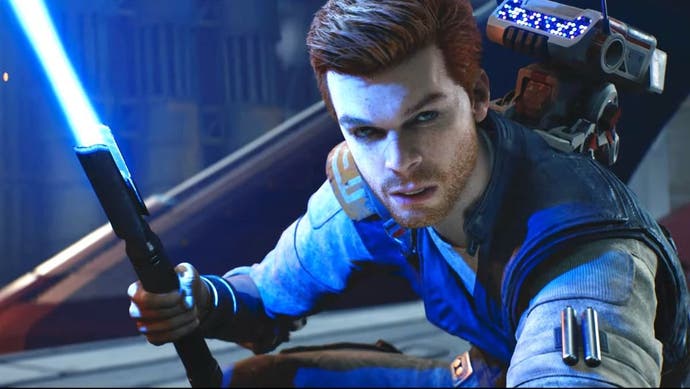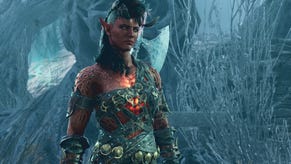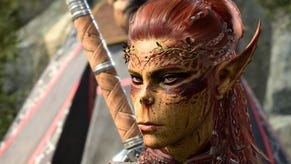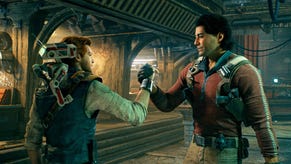Star Wars Jedi: Survivor finally delivers the 60fps mode we should have had at launch
RT is gone, performance improves - but some issues remain.
Star Wars Jedi: Survivor is arguably one of the most visually impressive console games this generation. Marrying extremely high-quality assets with excellent lighting and filmic post-processing, it's easily the best that Star Wars has looked in the realm of real-time rendering - but the game was let down by a few key faults. The good news is that the recently released patch addresses a lot of our concerns and the performance mode is much improved. The PC version? We'll be looking at that separately, but while the addition of DLSS and frame generation is great, there are still foundational problems with that port.
Returning to the console builds, we noted a lot of issues with the PS5 and Xbox Series renditions of the game, even though it had much to commend it. Image quality was questionable, especially in the 60fps performance mode on PS5 and Series X, and the game suffered from numerous bugs, some of them limiting game progress. Frame-rates also weren't ideal, often rolling around in the 40-60fps range in more demanding sections during performance mode play. Numerous patches have come and gone and the bugs have mostly been ironed out, but the game's rendering issues have remained. Until now.
Jedi Survivor's seventh major patch does exactly what it advertises from a visual features perspective. That means the complete removal of the RT global illumination and RT reflections in the performance mode on PS5 and Series X - alongside unspecified "GPU and CPU optimisations" - to hopefully achieve better frame-rates. That includes the cutscenes, which still render at 30fps, but no longer feature ray tracing.
Removing RT global illumination is a sensible trade to make for the performance mode. At worst, it means substantially less refined lighting in areas of complex geometry or around small artificial lights. The old ray traced lighting often looked a bit brighter, as light more convincingly bounced through tight enclosed spaces. Occasionally the difference could look dramatic, although usually this was fairly subtle. An interesting side effect of this change is that new lighting detail no longer pops in as you traverse the environment, which could be slightly distracting before.
But just focusing on the areas where there is a significant difference would be overselling it, because most of the time any differences were quite subtle. In most scenes, you'd have to really examine the environment to appreciate the improvement, and many shots looked nearly identical. That's because both the rasterised and RTGI lighting setups appear to still mostly be depending on a baked GI pass, particularly for distant pieces of geometry. The RTGI appears to be probe-based and largely additive, not like the fine-grained per-pixel RTGI in a title like Metro Exodus: Enhanced Edition, for example. Its removal doesn't hurt the game as much as you might think.
The removal of RT reflections is a different story. Jedi: Survivor depended heavily on RT reflections in some areas in the launch code, which now receive screen-space reflections instead. Exactly how effective this is depends on the area. Sometimes they look fine, sometimes you get no reflection at all. However, relying on screen-space reflections causes untold issues when there's no information within space-space to produce them, producing matte in-game surfaces which look strange at times.
This revised approach to reflections rendering completely fails when it comes to water surfaces, where there are extremely pronounced SSR occlusion artifacts against any major body of water. It looks so bad here that removing SSR completely would be the right choice, at least in these areas. It seems pretty clear that the game wasn't designed from an artistic perspective to operate without RT reflections, as the results look very out of place, especially considering the relative sophistication of the game's visuals on the whole.
Those are the primary visual differences between the two patches. But the new patch sees some small improvements to foliage draw and shadows outdoors, which bring it in line with the quality mode. It seems as if cutting back on the ray-tracing has enabled Respawn to improve basic settings, which is noticeable in the long shots here on Koboh, though in more industrial areas the differences are minimal.


Removing RT also improves image quality in that native rendering resolutions increase, which also serve to diminish some of the tell-tale artefacts of FSR 2 upscaling. There's still some artifacting in motion and some substantial aliasing, so I don't mean to say that the game is perfectly smooth when playing. But around previous trouble spots - like around the legs of the player character while running - Jedi: Survivor resolves a better image.
I tested a number of shots across both patches and there's a substantial increase in the base resolution of the image. Previously, the game usually rendered around 720p, and now we're usually just a bit short of 1080p. The output target appears to be roughly 1440p or so, but the increase to internal resolutions makes for a significant improvement to image quality. The UI does look substantially rougher though, suggesting that the original 4K UI has been downgraded to something in the region of 1440p.
Thus far, everything I've described applies equally to both PlayStation 5 and Xbox Series X and the good news is that this all applies to performance as well. At launch, frame-rates were pretty rough, typically averaging between 40 and 60fps on PS5 and Series X in the opening mission, with lows in the 30s. Some of the more naturalistic environments ran better, but still suffered from relatively frequent frame-rate dips.
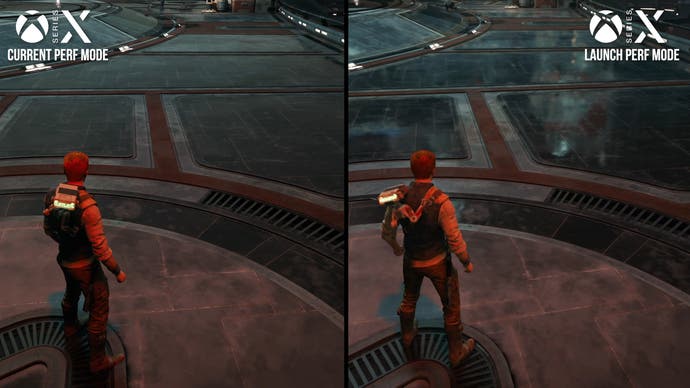
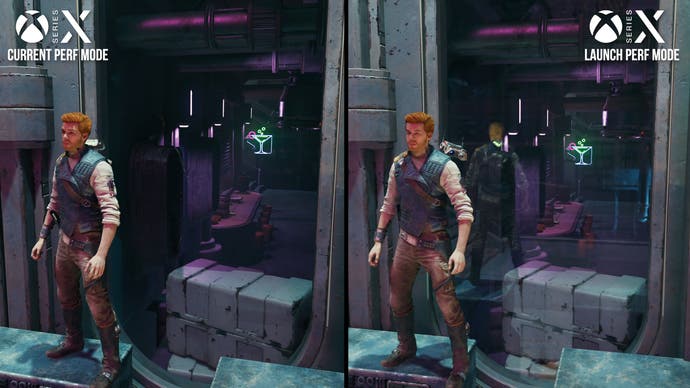
As of the latest patch, this has been almost completely ironed out. As far as I can tell, the game is a straight 60fps during typical play, even during very demanding moments. Some traversal stutter remains, but it's not terribly intrusive on the experience and sometimes amounts to a single dropped frame. This is true on both Series X and PS5, which have a similarly smooth frame-rate readout. That's great news, and Jedi: Survivor feels really solid now at 60fps.
Outside of the performance mode, Jedi: Survivor operates similarly to how it functioned at launch, with the exception of the game's various bug fixes. The quality mode remains for users who want to retain the ray tracing features but with a 30fps update instead of 60fps. Unsurprisingly, this mode looks about the same as it did at launch, with internal resolutions around 1152p or so upsampled to a full 4K with the use of FSR 2.
At launch, this mode was mostly stable but could suffer from significant performance drops in select moments during intense combat encounters, loading thresholds, and demanding cutscenes. In the updated version, these issues are mostly still present. There has been some improvement for sure, but the game still drops frames in roughly the same spots throughout the opening hour or so. These dips are noticeable but not hugely impactful, and are mostly absent in the game's more naturalistic areas.
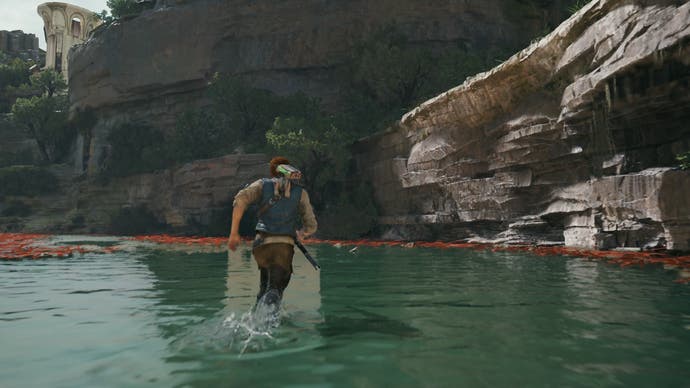
There is one exception though. This stream in Koboh was a trouble spot in the original release on PS5 in the quality mode, running in the low 20s and worst. Well, performance has changed, but not for the better. We're now bottoming out around 10fps for some reason. Subsequent runs ran around the mid-20s just like before, but this issue - as well as some others I experienced while playing - are evidence of a game that isn't quite as stable as it should be.
The new patch mentions that "variable refresh rate support was added for PS5". I briefly tested this out and didn't notice anything too out of the ordinary, as the game still seems to operate at 30fps and 60fps respectively in its two graphics modes in a 60Hz container, even with 120Hz enabled through the system settings. The game does present without tearing and feels pretty smooth within a limited range of frame-rates, so I suspect LFC is present here, but once we fall below 24fps or so the tearing and judder return.
Finally, Series S also behaves more or less as it did at launch. There's no ray tracing and no 60fps support here, so users are left with a 30fps mode without RT that targets a 1080p output. Performance is quite consistent thankfully and the game still looks perfectly good, but it would have been interesting to see a 60fps option, even if it meant a substantial reduction to image quality.

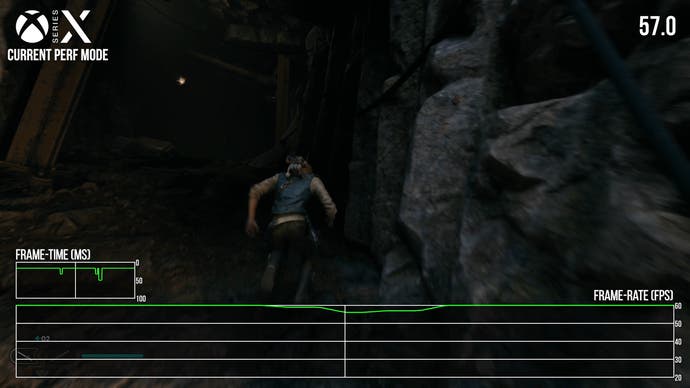
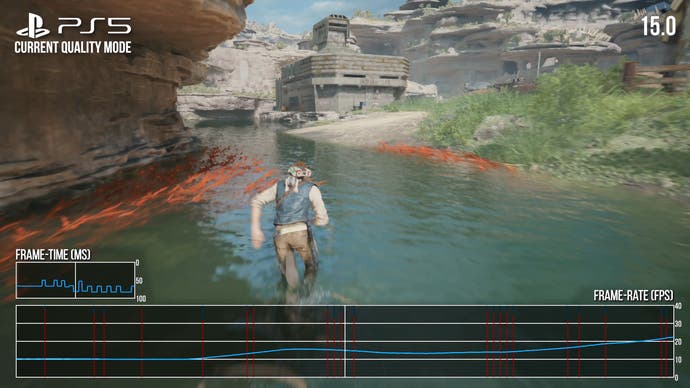
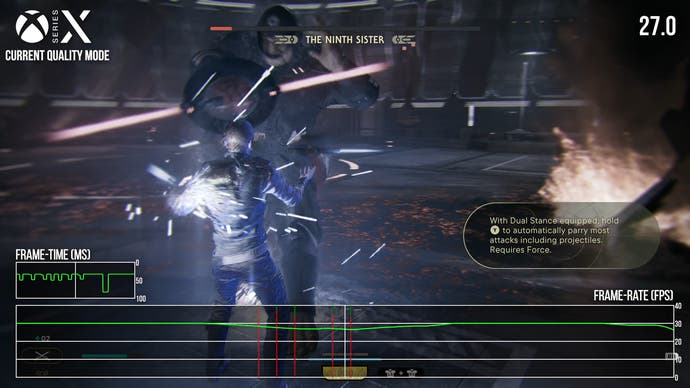
In summary, Star Wars Jedi: Survivor remains a superb looking game, and the new and improved performance mode solves the biggest long-standing issues with the game since its launch some five months ago. The performance mode's frame-rates and image quality have both been improved, at the expense of ray tracing effects that didn't always make a notable impact on the game's visual presentation.
It's a little bit curious that it took this long, as the fix seems relatively simple. And we know from the Series S and PC versions that Jedi: Survivor has a pretty good raster-only rendering mode, relying on precomputed GI and screen-space effects to fill in the rendering gaps. I would still like to see some work done to address some of the issues with screen-space reflections, as there are mixed results when the effect is applied more liberally. Simply disabling it on problematic surfaces would be a reasonable call.
Still, I'd personally prefer to play Jedi: Survivor on consoles in the updated performance mode, given how the game feels and animates with a smoother 60fps refresh, something that still seems to be beyond the PC version based on first impressions. Ultimately though, the console versions' performance modes have improved significantly - and it's much closer now to how the game should have shipped at launch.
